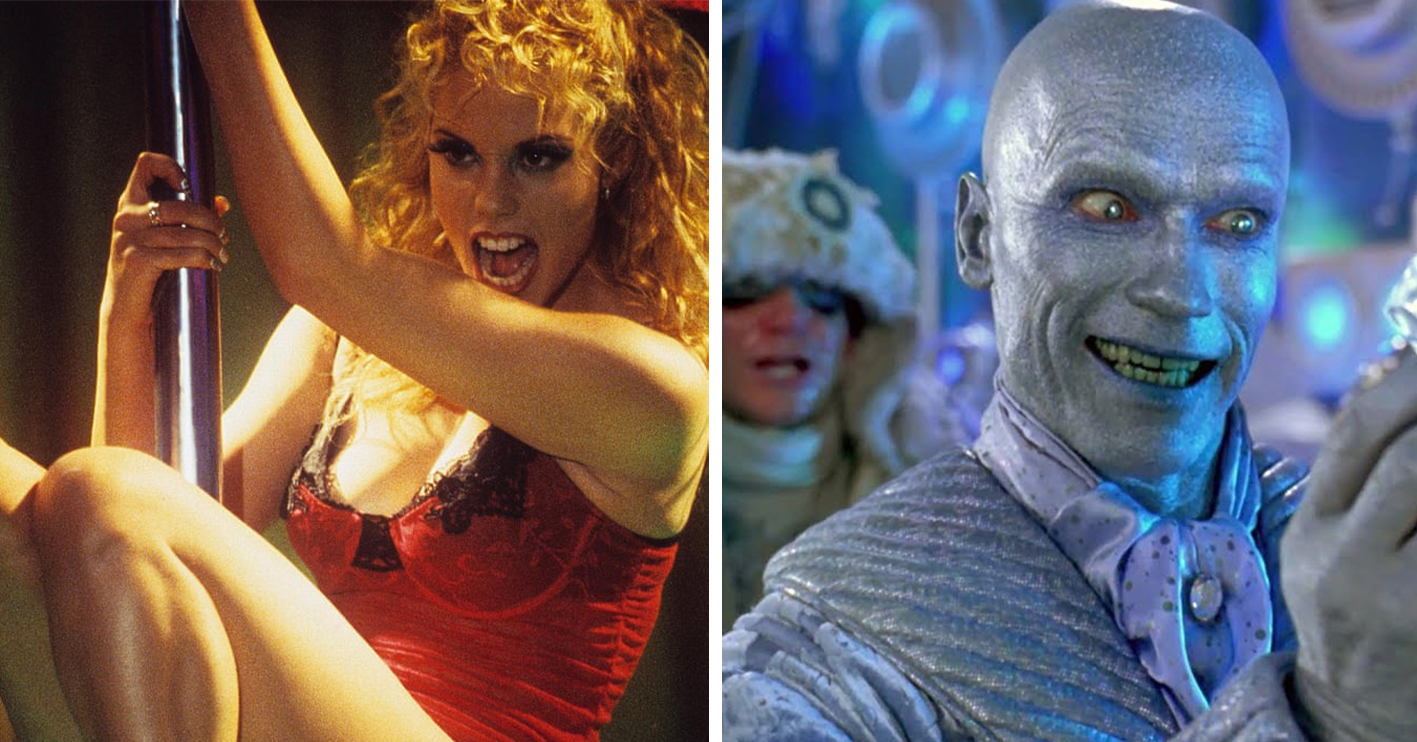We all have our share of cinematic guilty pleasures: films that we know to be terrible, but which we can’t help enjoying anyway.
As we’ve detailed before, there was certainly no shortage of good-bad movies to choose from in the 80s – but the decade that followed had more than its share of those as well. Join us now as we revisit what we consider to be the best worst movies the 90s had to offer…
30. Showgirls
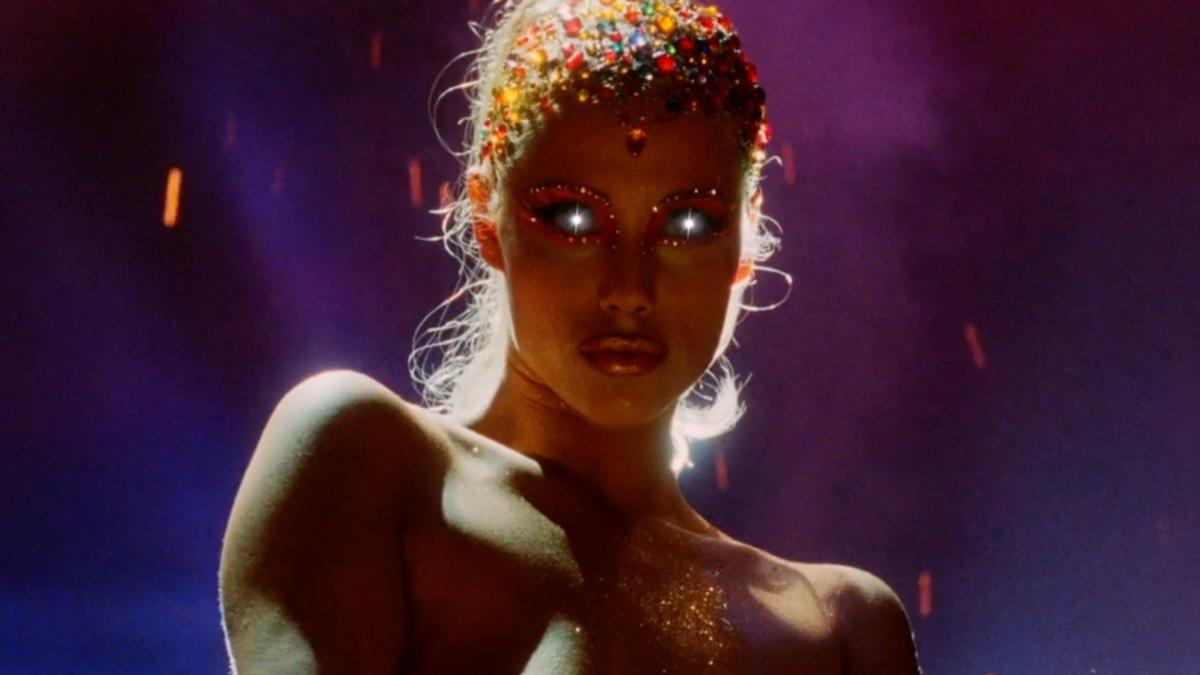
Let’s start as we mean to go on. In the annals of bad movie history, this one has become a true legend. 1995’s Showgirls reunited director Paul Verhoeven, producer Mario Kassar and screenwriter Joe Eszterhas after the massive box office success of Basic Instinct. After that movie pushed the boundaries for sex in the cinema, they hoped to go one better with their follow-up by making the first NC-17 rated blockbuster – but they failed, big time.
We don’t know whether to blame Verhoeven’s direction, Eszterhas’ writing or the mind-blowingly over-the-top performance of Elizabeth Berkley. All these elements combined make Showgirls one of the most laugh-out-loud ridiculous movies ever made. The movie swept the board at the 1996 Golden Raspberry Awards – and Paul Verhoeven made history as the first recipient to show up to the ceremony and accept his Razzies in person. Showgirls bombed terribly on release, but has long since been embraced as a camp classic.
29. Batman & Robin

The recent movies made in the DC Universe have left more than their share of viewers displeased. Still, no superhero movie to this day has been as unanimously lambasted by comic book fans as 1997’s Batman & Robin. Director Joel Schumacher’s movie is so camp and outlandish that it makes the 60s Batman TV show seem grounded, which is no mean feat. Met with an almost universally negative response, Batman & Robin single-handedly killed the Batman series for almost a decade, and derailed the careers – temporarily and longer-term – of many of its actors.
Still, can we be forgiven for admitting we crack a smile every time we see the film? There’s a charm to its innate stupidity, with its garish sets and costumes and absurd twists. And don’t even get us started on the unstoppable deluge of ice-related puns falling from the lips of Arnold Schwarzengger‘s chilly antagonist Mr Freeze.
28. Congo

In the wake of Jurassic Park, any big-budget movie based on the writing of Michael Crichton seemed like a sure thing. However, director Frank Marshall (Arachnophobia, Alive) bit off a bit more than he could chew with his 1995 adaptation of Crichton’s 1980 novel Congo. It’s one thing making a blockbuster about dinosaurs in the present day; it’s quite another when the centrepiece is an ape who can talk through a machine that deciphers sign language.
Congo is a very weird, inconsistent and silly film indeed, but it’s certainly not short on novelty value. On top of Amy, the talking ape with a taste for Martinis, we have Ernie Hudson doing a plummy English accent, Tim Curry playing Russian and – the surest sign of B-movie status – a hammy cameo from Bruce (Army of Darkness) Campbell. That’s not forgetting Congo’s rampaging hordes of white apes, and what has to be the largest scale hippo attack in Hollywood history.
27. Street Fighter
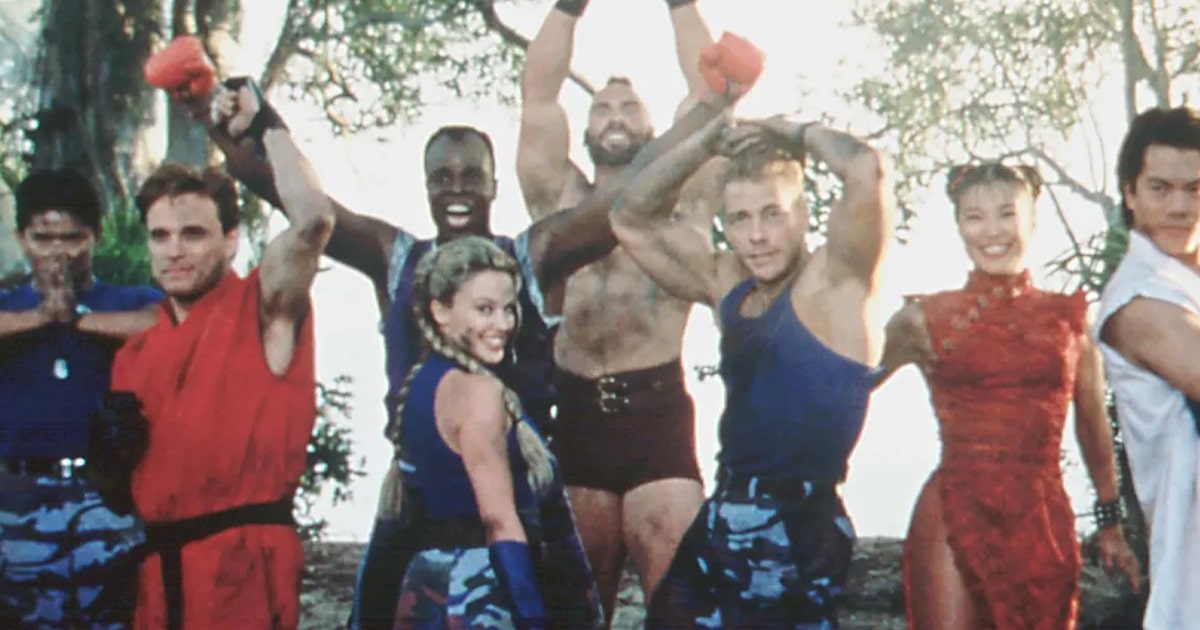
Capcom’s video game Street Fighter II captivated gamers the world over in the early 90s. However, the same can’t necessarily be said of the 1994 big-screen adaptation of the franchise. Writer-director Steven De Souza took the characters from the one-on-one beat-’em-up and threw them headfirst into a madcap James Bond-esque action-adventure, with eye-popping costumes and over-the-top performances all over the shop. Street Fighter proved a reasonable box office success, but even those who enjoyed it will admit that it’s exceptionally dumb.
Rarely has leading man Jean-Claude Van Damme given a more haphazard performance (reports state he was under the influence of a variety of substances for most of the shoot). However, the film’s one true saving grace is the tremendous turn from Raul Julia as villain M Bison, in what sadly proved to be his last performance.
26. Barb Wire

Pamela Anderson was one of the biggest small-screen sex symbols of the 90s thanks to her role on Baywatch. It was only logical, then, that Anderson would land herself the lead in a major movie capitalising on her provocative public persona. Unfortunately, the film in question turned out to be 1996’s shambolic sci-fi thriller Barb Wire. Loosely based on the Dark Horse comic book, Barb Wire is torn between persistently fetishising its leading lady and re-enacting the plot of Casablanca in a semi-apocalyptic future. (No, really, it’s pretty much a Casablanca remake, although Anderson’s a very unlikely Bogart.)
The presence of a skin-tight leather-clad Anderson (or rather Anderson Lee, as she was then known, during her scandalous marriage to Mötley Crüe‘s Tommy Lee) didn’t prove much of a box office draw; Barb Wire scraped a meagre $3.8 million in ticket sales. It’s all very cringe-inducing, and most of the cast look embarrassed to be there, but the film is sure to raise its share of smirks regardless.
25. The Lawnmower Man
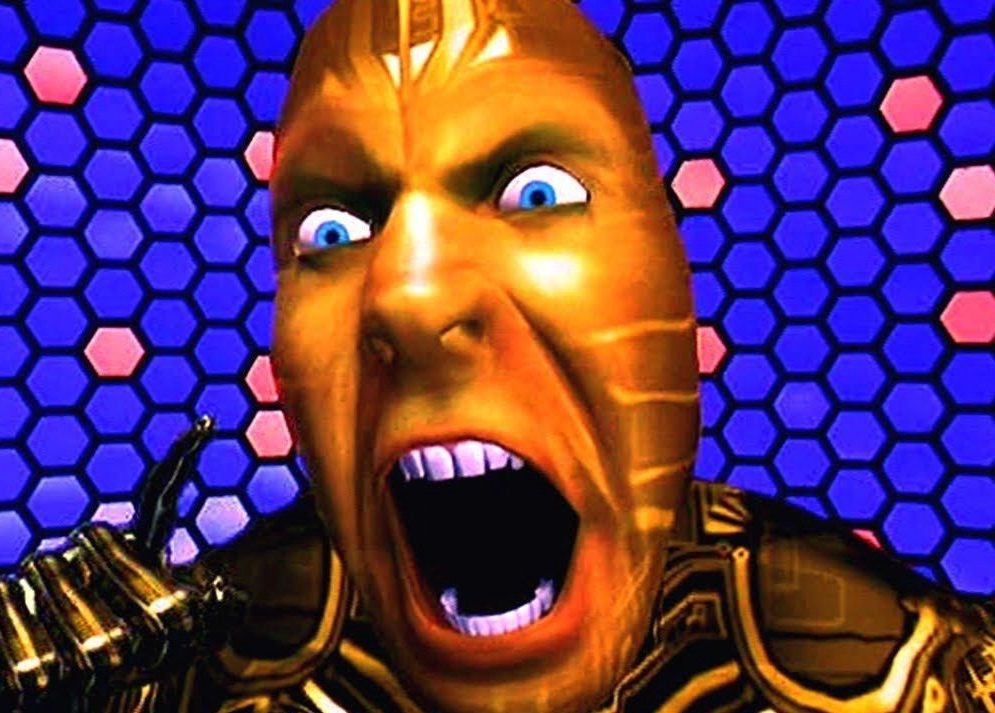
As the 90s began, virtual reality was just starting to enter the popular consciousness – and, like any new technology, people were freaked out by it. In which case, what could be scarier than a movie about virtual reality based on a story by Stephen King? Alas, 1992’s The Lawnmower Man – in which a scientist (Pierce Brosnan) uses a VR program to enhance the mind of a mentally challenged gardener (Jeff Fahey) – proved more likely to leave audiences screaming with laughter than terror. Filled with CGI that looked awful even at the time, The Lawnmower Man is an embarrassing blip on the resume of a pre-Bond Brosnan.
It’s also the only time Stephen King has sued the makers of a film based on his work, which is quite an achievement when you consider how many terrible King adaptations there have been over the years. The author was outraged that the film had been promoted as ‘Stephen King’s The Lawnmower Man,’ when it bore almost no resemblance to his original story.
24. Showdown in Little Tokyo
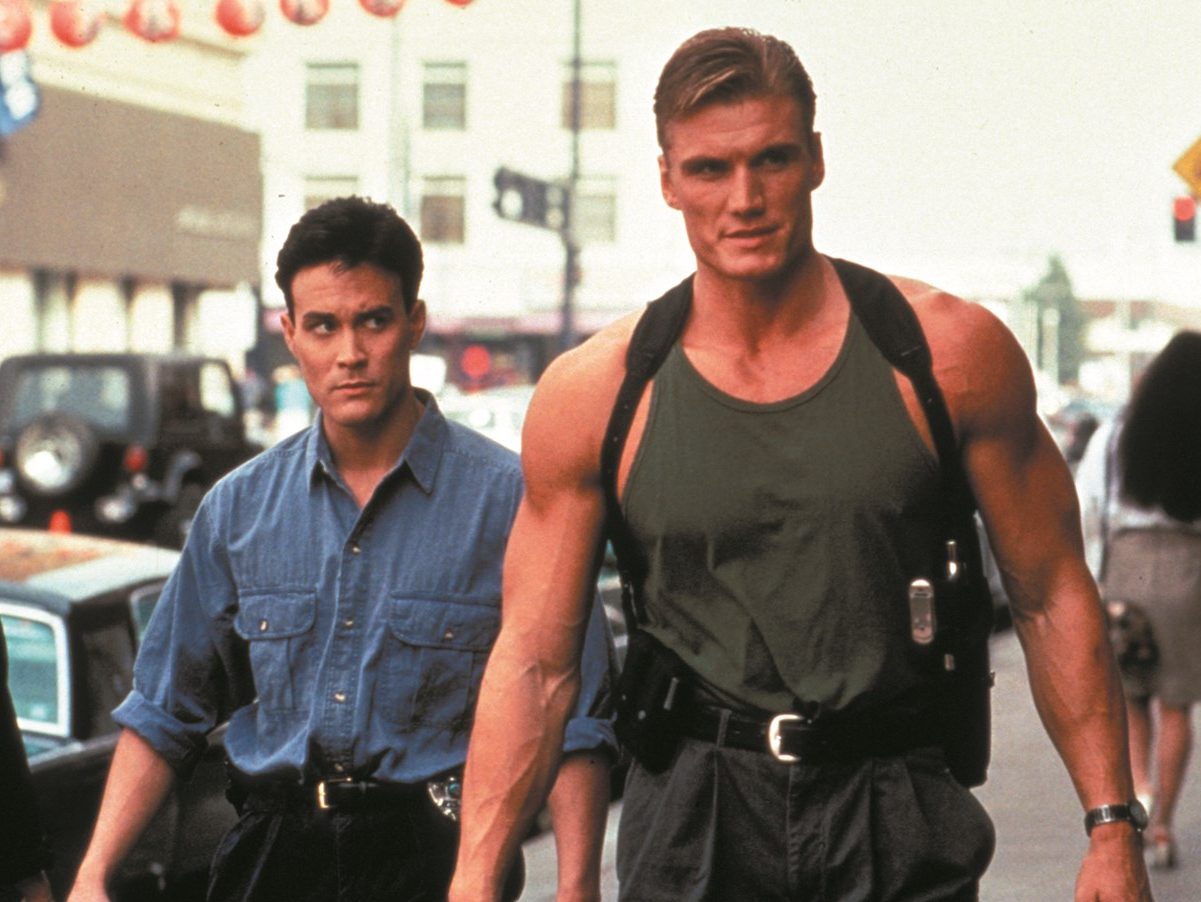
At the dawn of the 90s the buddy cop movie craze was at its peak, in the wake of hits like Lethal Weapon and Tango & Cash. Following this trend, studio Warner Bros teamed established action man Dolph Lundgren with young up-and-comer Brandon Lee in 1991’s Showdown in Little Tokyo. Directed by Mark L. Lester (Commando), the movie casts its ultra-macho leading men as cops investigating Japanese gangsters suspected of murder, resulting in an extremely cartoonish culture clash.
Showdown in Little Tokyo is filled to the brim with absurd action and breathtakingly bad dialogue (one particular exchange between Lee and Lundgren has become legendary). The film’s box office failure sucker-punched Lundgren’s career – he hasn’t taken top billing on another theatrically released film since. Tragically, Brandon Lee would only headline one more movie in his lifetime, 1992’s Rapid Fire, before his accidental death on the set of The Crow.
23. The Island of Dr. Moreau
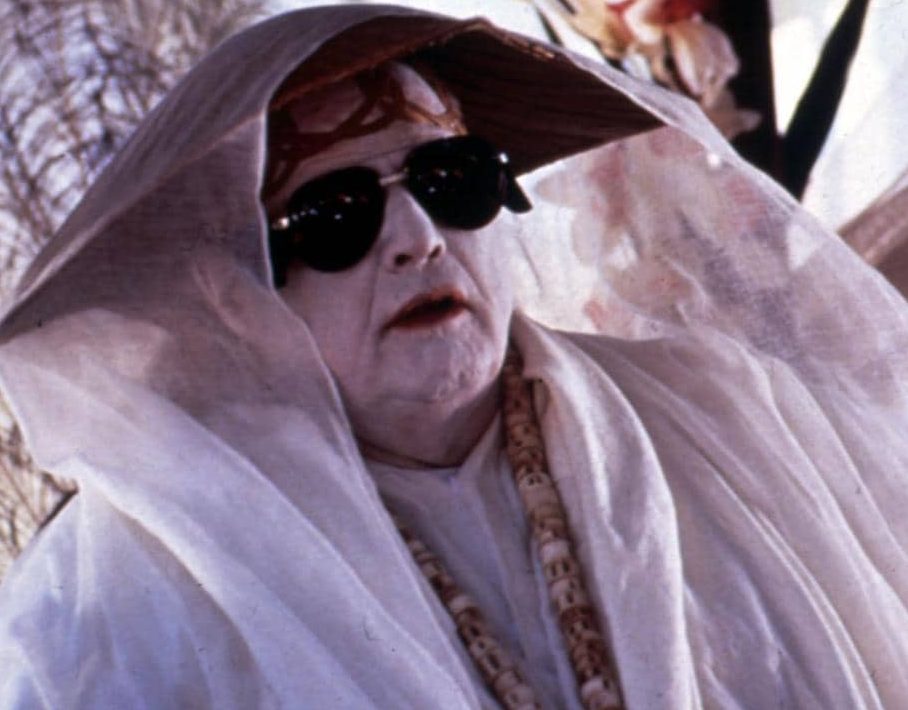
This adaptation of H.G. Wells’ 1896 novel began as a lifelong dream project for director Richard Stanley. In the end, however, The Island of Dr. Moreau wound up being a nightmare for just about everyone involved. Notorious for its behind-the-scenes drama, the 1996 sci-fi horror was the textbook definition of a ‘troubled production,’ as detailed at length in the excellent documentary Lost Soul. Original director Stanley was fired in the first few days, Val Kilmer was being the biggest diva imaginable and film icon Marlon Brando came to the set grief-stricken from the recent death of his daughter.
Ultimately overseen by director John Frankenheimer, The Island of Dr. Moreau is almost hypnotic in its strangeness and unintentional hilarity. Today the film is mostly remembered for ending Kilmer’s reign as a major leading man, and for providing the inspiration behind Mini-Me in the Austin Powers movies.
22. Tammy and the T-Rex
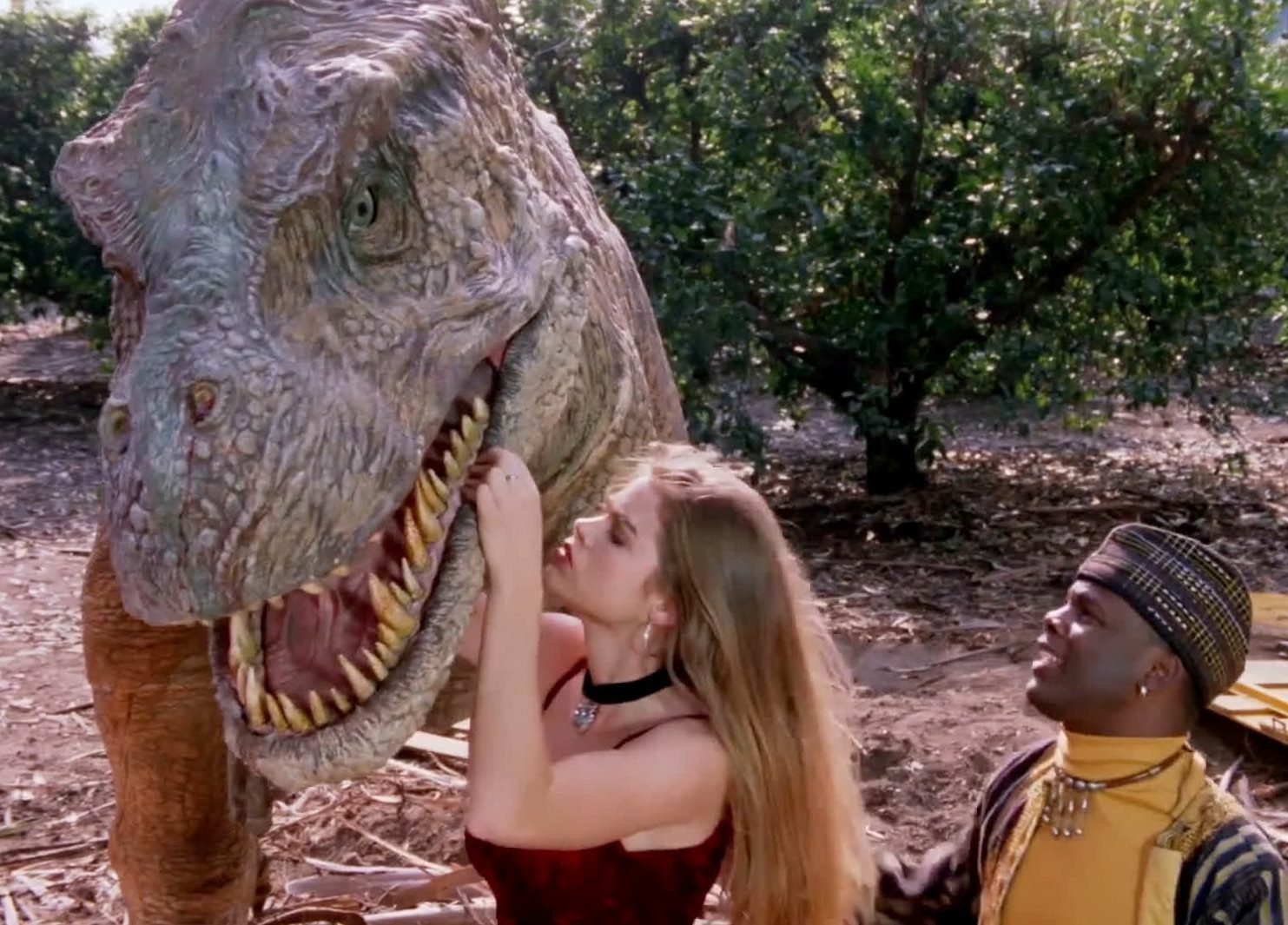
It’s likely some readers are unaware of this early piece of work from future superstars Denise Richards and Paul Walker, so please believe us when we assure you this is a real movie. Mike (Walker) is a high school footballer who is mauled by a lion when school bullies dump him in a wildlife park. (Good start, eh?) At the point of death, Mike’s brain is placed into the body of an animatronic Tyrannosaurus Rex by a mad scientist. Why? Don’t ask such silly questions.
Then, in his new T-Rex body, our young hero sets out to get revenge on his murderers, and be reunited with his cheerleader girlfriend, Tammy (Richards). Tammy and the T-Rex is the work of Stewart Raffill, the writer-director behind the similarly trashy Mac and Me, which might account for what an audaciously silly film it is. Originally released in a neutered PG-13 cut, the 1994 comedy horror has become a cult favourite in recent years after it was re-released with its gory death scenes reinstated.
21. Troll 2

If you’re looking for a movie that has it all – bad writing, bad directing, bad acting, bad special effects, bad make-up, bad music, and just overall bad decision-making all around – then you can’t do better (or maybe worse) than 1990’s Troll 2. A sequel in name only to 1986 horror Troll, this legendarily terrible movie follows an all-American family on vacation in a remote country town called Nilbog, only to find themselves under attack by goblins. (There’s a clue in the town’s name…) However, as these goblins are vegetarian, they have a devious plan: to turn the family into vegetables, then eat them.
Hilariously awful from start to finish, Troll 2 sports some of the most unforgettably insane dialogue and imagery you’re ever likely to see, handled with the least possible amount of finesse. The film’s bizarre tone makes a degree of sense when you learn that the film’s Italian director, Claudio Fragasso, barely spoke English and struggled to convey information to his American cast, none of whom were professional actors. A confirmed cult classic, Troll 2’s reputation later inspired its young star Michael Paul Stephenson to direct the 2009 documentary Best Worst Movie, exploring the film’s dubious legacy.
20. Spice World

Now and then, pop groups decide to make a movie. This might have worked for the Beatles in A Hard Day’s Night and Help!, but outside of those examples, many of the results have been debatable at best. Case in point: 1997’s Spice World, the first (and only) movie centred on the Spice Girls, made when the British pop quintet were the most popular band on the planet. No one expected the film to be another Citizen Kane. Even so, few could have anticipated Spice World being quite so bonkers as it turned out to be.
Essentially plotless, Spice World’s stream-of-consciousness narrative follows the pop superstars through their day-to-day life in a slew of cartoonish comedy set-pieces, loaded with cringeworthy gags galore. Along the way they pile on the celebrity cameos, with notable appearances from Richard E. Grant, Alan Cumming, Jennifer Saunders and perhaps most famously Roger Moore. The reviews largely derided Spice World as mindless nonsense, but this didn’t stop the film from being a hit, taking over $100 million at the box office.
19. Anaconda
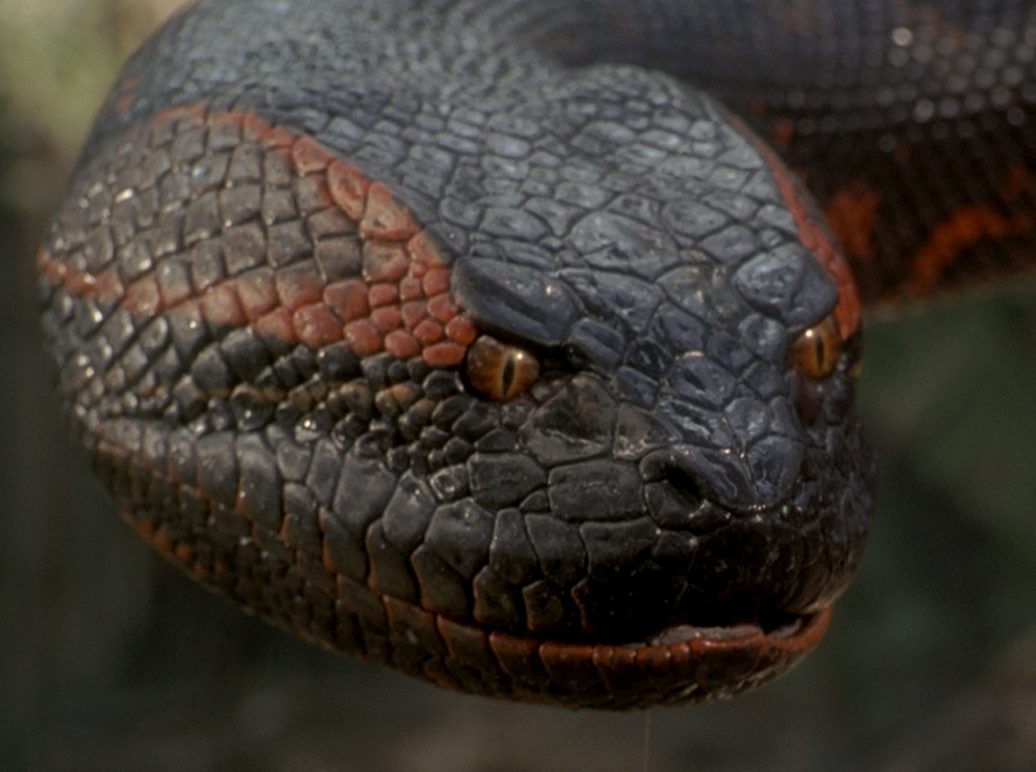
Long before the word Anaconda was co-opted by Nicki Minaj, the giant snake was synonymous with this crazy 1997 creature feature. Any movie which centres on explorers crossing paths with a giant man-eating snake on the Amazon river was always going to be a bit wacky. Curiously though, the snake itself winds up playing second fiddle to an outrageously over-the-top performance from one-time Oscar winner Jon Voight.
Cast as the duplicitous Paraguayan snake hunter Paul Serone, Voight seems hellbent on chewing up every last square inch of scenery. In the meantime, Voight’s co-stars Jennifer Lopez, Ice Cube, Owen Wilson and Eric Stoltz can’t do much but look a bit uncomfortable with the whole endeavour. Critics blasted it, but Anaconda proved enough of a hit to spawn a slew of direct-to-DVD sequels (including 2015’s Anaconda vs. Lake Placid, a crossover with the giant crocodile series).
18. Super Mario Bros

Video game movies were a new thing in the 90s, and (as we’ve established already) the subgenre didn’t get off to the most illustrious of starts. Still, while Street Fighter has its problems, these pale in comparison next to the utterly mind-boggling spectacle that is 1993’s Super Mario Bros: The Movie. Another enormously troubled production, this big screen take on Nintendo’s signature franchise was plagued with behind-the-scenes disagreements over its tone and content. While the financiers wanted something kid-friendly and fun, directorial duo Annabel Jankel and Rocky Morton wanted to make something darker and more adult-oriented.
The end result was this weird hodgepodge of Blade Runner-esque dystopian sci-fi and pseudo-Spielberg family adventure, which is most notable for bearing virtually no resemblance to the colourful world of the original video games. Super Mario Bros was a critically savaged flop, which leading man Bob Hoskins later declared the biggest regret of his entire career – but it’s also attained an enthusiastic cult following over the years.
17. Entrapment
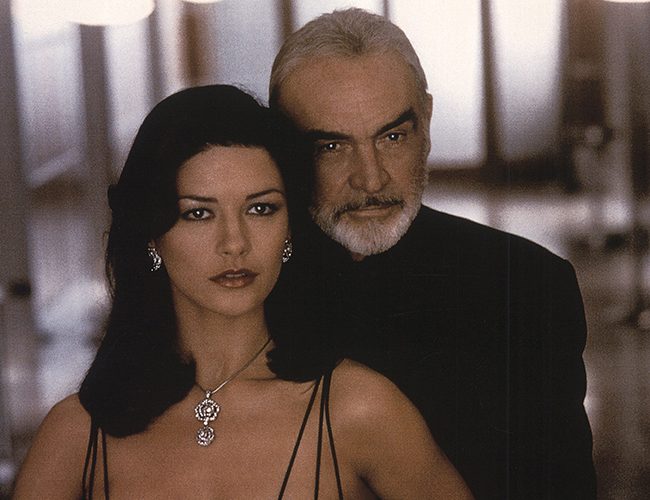
This corny crime caper arrived right at the tail end of the 90s, but it’s too great a guilty pleasure for us to overlook it. Entrapment gave Catherine Zeta-Jones one of her first major leading roles as an insurance investigator hot on the tail of Sean Connery‘s legendary thief. The fact that a romance blossoms between the 68-year-old Connery and the 29-year-old Zeta-Jones is the first red flag. Then there’s the fact that the Welsh Zeta-Jones is trying out an American accent for the first time, to somewhat questionable effect.
Peppered with terrible dialogue and implausible twists, Entrapment tries hard to elicit thrills and sexual tension, but mostly only provokes unintentional laughter. Zeta-Jones is constantly trying too hard, whereas Connery is putting forth so little effort he generally looks like he’s about to fall asleep. Even so, Entrapment did prove a hit with box office takings of over $212 million, despite the mostly unkind reviews.
16. Species
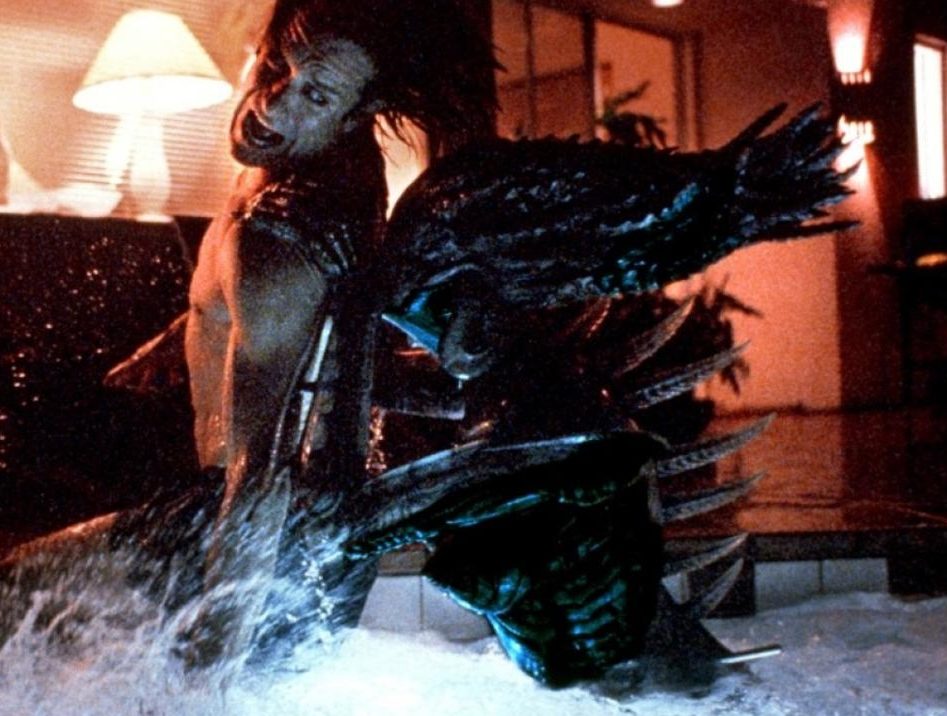
There aren’t too many sci-fi horror movies with central concepts quite so eye-opening as that of 1995’s Species. After receiving a mysterious transmission with instructions on merging human and alien DNA, a team of scientists led by Ben Kingsley create a female humanoid named Sil from this genetic code. Maturing at an alarming rate, Sil (played first by a young Michelle Williams, then by Natasha Henstridge) breaks out of the lab and heads out into the world with one thing in mind: finding a mate, and breeding more alien-human hybrids like her.
In other words, it’s all about a super-powered, bloodthirsty alien nymphomaniac on the rampage. Not necessarily one to watch with all the family, then. Species is one of those films that’s so bananas, you wonder how so many respected figures got on board with it, not least its impressive ensemble of Kingsley, Michael Madsen, Forest Whitaker, Marg Helgenberger and Alfred Molina. Despite its illustrious cast, Species is most memorable for Natasha Henstridge’s frequent gratuitous nudity, and the suitably garish monster designs by legendary Alien creator H.R. Giger.
15. Teenage Mutant Ninja Turtles II: The Secret of the Ooze

As anyone who was a child in the 80s and/or 90s can tell you, there wasn’t a kid alive back then who didn’t love the Teenage Mutant Ninja Turtles. After the success of the toy line and TV cartoon, 1990’s live action Teenage Mutant Ninja Turtles movie was a huge hit, but also the cause of some controversy. Many parents and critics complained that studio New Line Cinema had made the first Turtles movie far too dark and violent for the kids it was aimed at, so they made a point of lightening things up on the sequel.
However, it’s possible the filmmakers went a little too far in that direction, as 1991’s Teenage Mutant Ninja Turtles II: The Secret of the Ooze is one of the goofiest blockbusters you’re ever likely to see. Garishly colourful and packed with infantile humour, this live-action sequel is way more cartoonish than the Turtles cartoon itself ever was. It’s also a great time capsule for early 90s pop culture, not least thanks to its cameo from one of the most notorious pop idols of the time, Vanilla Ice.
14. Embrace of the Vampire

It’s long since been a bit of a cliche that former child stars, actresses in particular, will seek to shake off their old image in adulthood by taking on raunchier material. In between her stints on TV hits Who’s the Boss? and Charmed, Alyssa Milano did this very thing in 1995’s Embrace of the Vampire. Just to add to the novelty value, this straight-to-video erotic horror also casts Spandau Ballet‘s Martin Kemp as the vampire in question.
Milano’s virginal good girl Charlotte is haunted by visions of Kemp’s undead lothario. Believing her to be the reincarnation of his lost love, the vampire strives to make Charlotte embrace her long-repressed desires so that she can join him on the dark side for all eternity. Embrace of the Vampire is very trashy indeed, and extremely dated in its music and visuals, but it’s hard to deny the film’s lurid entertainment value. Milano would go on to work with the film’s director Anne Goursaud again on the similarly sleazy Poison Ivy II – and in 2013, Embrace of the Vampire spawned a remake, which also went direct to home entertainment.
13. Bio-Dome
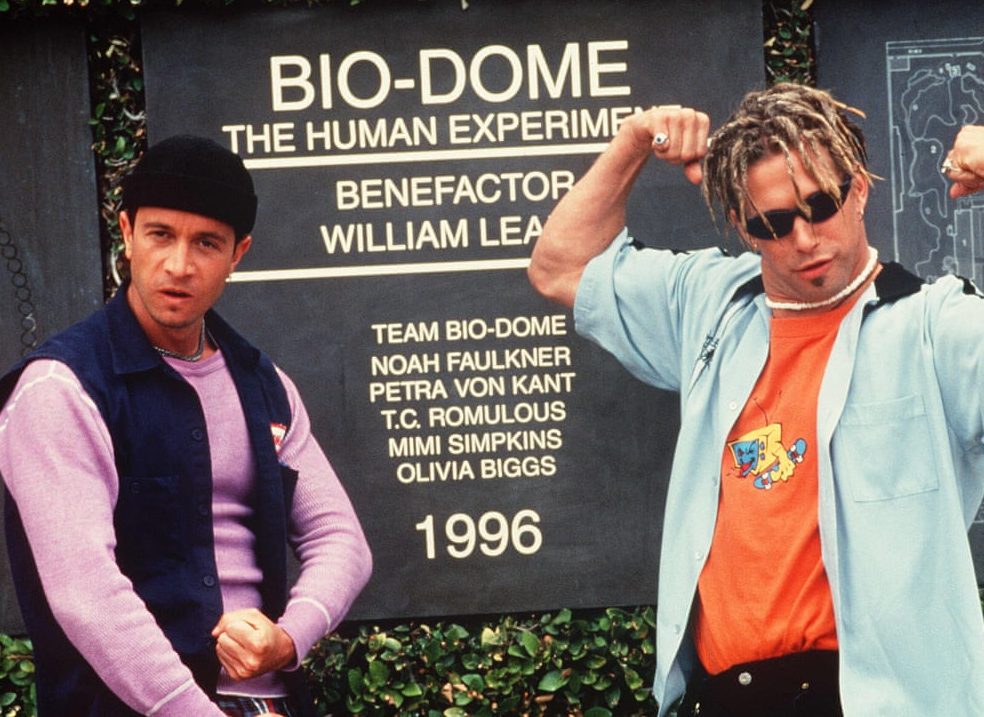
Long ago, in an age before Dude, Where’s My Car? and White Chicks, one actor dominated the field of dumb comedy movies: Pauly Shore. After rising to fame with Encino Man, Shore went on to a series of ultra low-brow comedies built around his distinctive persona. None of Shore’s films went down well with critics – but 1996’s Bio-Dome was the biggest bomb of them all.
The film casts Shore and Stephen Baldwin as two slacker buddies who accidentally find themselves locked inside an experimental biosphere with a team of scientists. It may attempt to tackle the environmental issues that were gaining prominence in the 90s, but for the most part Bio-Dome is only interested in exploring the lowest depths of stoner humour. Though it’s strangely compelling in its awfulness, Bio-Dome more or less ended Shore’s career, and the mind boggles that Baldwin chose to star in it so soon after his turn in Oscar-winning hit The Usual Suspects.
12. Tank Girl

1995’s Tank Girl is revered by some as a key entry in the comic book movie genre, and one of the few major movies of the 90s made by a predominantly female crew. This doesn’t change the fact that it’s a deeply flawed and inconsistent piece of filmmaking that massively diverges from the comic it’s based on. Lori Petty takes the title role of the sarcastic, rebellious heroine battling an evil corporation in a dystopian future wasteland.
Tank Girl is another film that was beset with behind the scenes trouble, as director Rachel Talalay constantly found herself at loggerheads with the studio over the film’s outlandish and at times provocative content. What we’re left with is a film that’s primarily concerned with coming off hip and alternative. As a result, it feels like a self-parody with its over-abundance of grunge-era music and fashions, and excessively cartoonish humour. The critics hated Tank Girl, and with earnings of only $6 million it tanked (pun intended) at the box office; but it’s another movie that enjoys a healthy cult following today.
11. On Deadly Ground
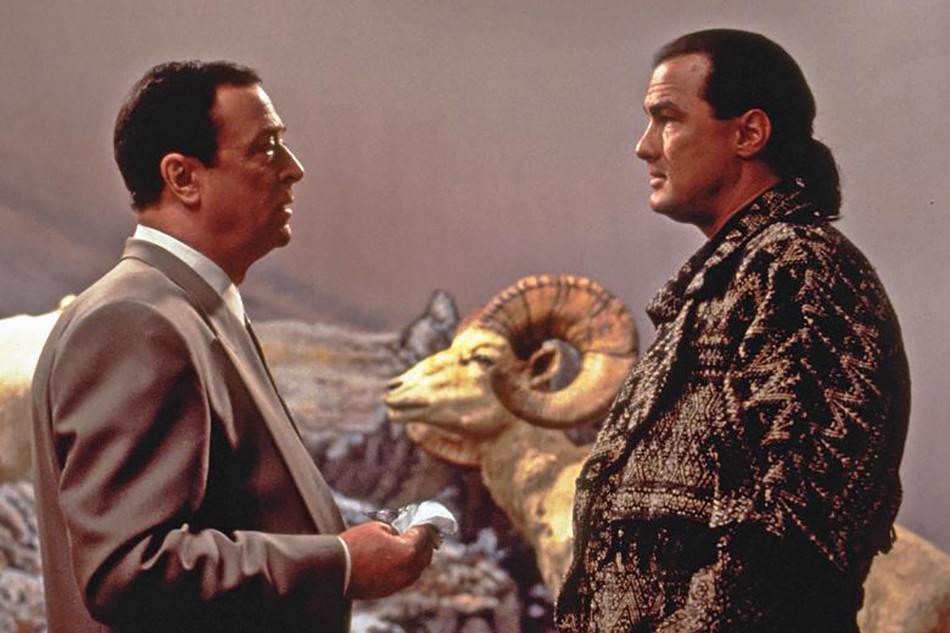
Steven Seagal has a somewhat curious heritage among big screen action heroes – not least because, aside from Under Siege, none of his movies were ever particularly big hits. Even so, by 1994 Seagal pulled enough weight in Hollywood to be allowed to direct his next star vehicle, On Deadly Ground. An effort by the martial arts star to highlight his environmental concerns, the film casts Seagal as a maverick Alaskan firefighter at loggerheads with a corrupt oil company run by an unscrupulous Michael Caine (who has long since admitted he only did the film for the money).
All the inherent absurdities of Seagal’s screen persona are in full force here, from his slick-backed ponytail to his gaudy dress sense, plus a penchant for delivering portentous monologues in a low mumble. What makes On Deadly Ground most laughable is how, for all his speeches about respecting the planet, Seagal’s big heroic move is to blow up an oil platform in the final act; hardly an environmentally friendly course of action. On Deadly Ground received scathing reviews and failed to recoup its budget at the box office. Seagal hasn’t directed again since, and within a few years most of his movies were going straight to video.
10. Cool World

1988’s Who Framed Roger Rabbit proved two things: one, that live action/animation crossovers could work; and two, that grown men have no problem feeling sexually attracted to cartoon characters. 1992’s Cool World attempted to one-up that film (and in particular the character of Jessica Rabbit) with the creation of Holly Wood, an animated blonde bombshell voiced by, and modelled on, Kim Basinger. The bizarre black comedy sees ‘doodle’ Holly conspire to escape her animated dimension, the ‘cool world,’ and break through into the world of the ‘noids,’ i.e. humanity. And just how does she achieve this? By luring forth Gabriel Byrne, the cartoonist who created the Cool World (or so he thinks), and having sex with him – which will turn her into a human.
Cool World clearly has a rather adult concept, and its director Ralph Bakshi had previously worked in more adult-oriented animation. Yet reportedly at Basinger’s behest, efforts were made to tone things down for a more kid-friendly movie. Small wonder the film winds up making little sense, and leaves you wondering exactly who the audience is meant to be. Yet as baffled as we may be as viewers, that’s nothing compared to how bemused Gabriel Byrne and Brad Pitt look throughout the whole thing. One suspects both actors had some stern words to say to their agents about getting hired for this movie.
9. Prayer of the Rollerboys
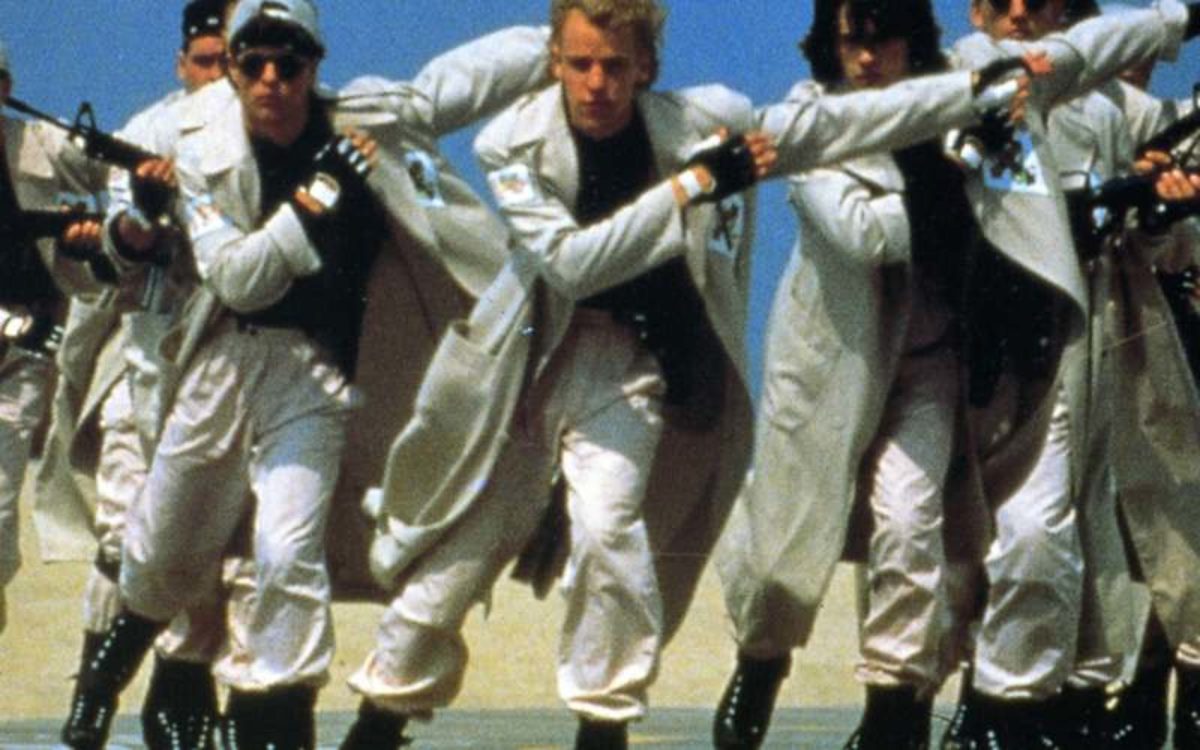
If you ever wanted to pinpoint where things started to go wrong for Corey Haim (professionally, at least), Prayer of the Rollerboys might be a good place to start. After becoming one of the biggest child stars of the 80s, the 90s got off on the wrong foot for Haim thanks to this thoroughly misconceived thriller. In a dystopian future in which everyone really loves inline skating, the streets are dominated by a gang of white supremacist drug dealers in rollerblades known as the Rollerboys. Haim’s rebellious teen Griffin joins forces with Patricia Arquette’s young undercover cop Casey to take the Rollerboys down from the inside.
The script by W. Peter Iliff (Point Break) tries hard to be topical and thought-provoking, but it’s clear that the filmmakers were mostly interested in trying to make an edgy, hip movie that teens of the time would respond to. Subsequently, Prayer of the Rollerboys winds up little more than a cut-price juvenile fantasy with delusions of grandeur (and is all the more unintentionally funny for it).
8. Cutthroat Island

It’s one thing for a movie to be bad, but it’s quite another when that movie winds up sinking an entire studio. That’s what happened with 1995’s Cutthroat Island, the pirate adventure starring Geena Davis and directed by her then-husband Renny Harlin, and which was the last film released by Carolco Pictures. Harlin may have been responsible for some of the great action films of the era (Die Hard 2, Cliffhanger), but he proved to be a little out of his depth attempting to capture the spirit of an old-fashioned swashbuckler. Things aren’t helped by the near-total lack of chemistry between Davis and her love interest Matthew Modine.
Another one beset by behind-the-scenes difficulties, Carolco were banking on Cutthroat Island being a big enough hit to save them from their financial woes. With this in mind, they sank a then-unusually high budget of $98 million into the film. Alas, this did not pay off, as Cutthroat Island was met with negative reviews and audience indifference, and took a mere $10 million at the box office. (This made it a far bigger money-loser than the same year’s Waterworld, which is often misremembered as the biggest flop of the 90s.) But hey; as misguided, overblown, over-priced box office disasters go, there are still considerably worse ways to waste a couple of hours than watching Cutthroat Island.
7. Speed 2: Cruise Control
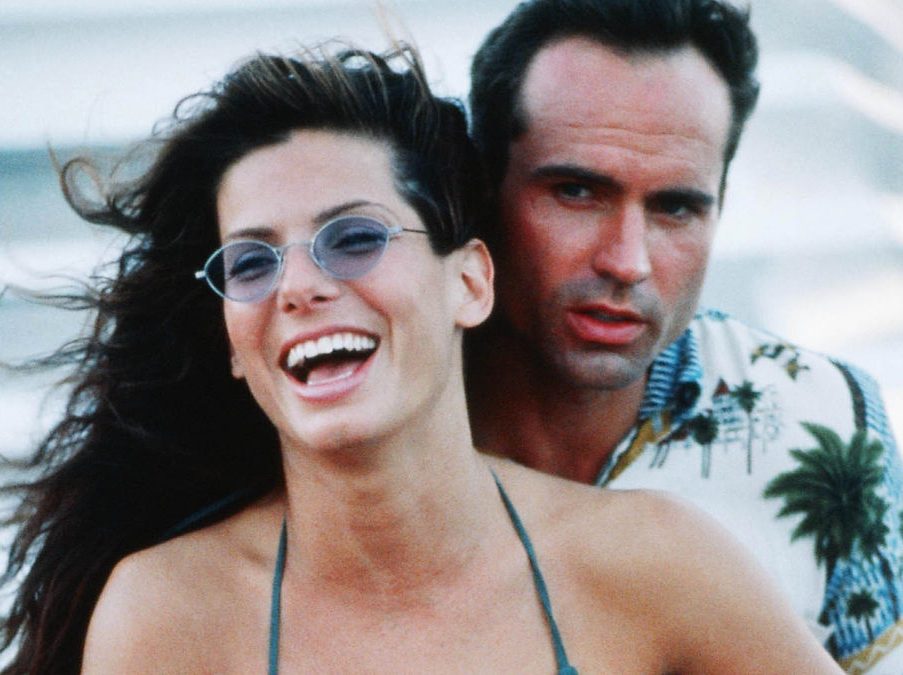
There’s an extra-special badness to movies that follow on from revered classics only to fall short on every level. It’s generally agreed that 1994’s Speed was one of the very best action movies of the 90s, so naturally studio 20th Century Fox wanted a sequel. But as the old adage goes, be careful what you wish for, as 1997’s Speed 2: Cruise Control wound up one of the most critically lambasted flops of the decade. The warning signs were there as soon as Keanu Reeves dropped out of the film, leaving a very uneasy-looking Jason Patric to take over as Alex, a new cop boyfriend to Sandra Bullock‘s Annie.
On top of which, it’s hard to believe that anyone thought a speeding cruise ship at sea was in any way as compelling a setting as a city bus that can’t slow down. Factor in that they chose to tone down the action for a PG-13 rating, and it’s small wonder fans of the original Speed felt robbed. Yet for all the many glaring mistakes of Speed 2: Cruise Control, it has one ace up its sleeve in the gloriously mad-eyed performance of Willem Dafoe as the bad guy.
6. Samurai Cop

There are good-bad movies, and then there are good-bad movies… and then there’s Samurai Cop. Released straight to video in 1991, writer-director Amir Shervan’s low budget schlockbuster is a masterclass in how not to make an action thriller. For starters, the film’s inexperienced leading man Matt Hannon (aka Mathew Karedas) had no martial arts training, and started shooting his scenes within a week of being cast. Due to the shoestring budget, director Shervan frequently refused to shoot more than one take of any scene, which might explain the somewhat stilted delivery of most of the dialogue; not that Shervan had exactly written an Oscar-worthy script in the first place.
Samurai Cop was pretty much forgotten for over a decade, before it accrued a cult following after its now-infamous nurse scene was widely shared in the early days of YouTube. In the years since, the film has been so warmly embraced by 21st century fans that it even got a belated sequel in 2015’s Samurai Cop 2: Deadly Vengeance.
5. Striptease

With the exception of Sharon Stone in Basic Instinct, not many 90s actresses helped their career by taking a leading role in a high profile sexually-charged movie. As if Elizabeth Berkley’s performance in Showgirls wasn’t sufficient evidence of this point, look no further than Demi Moore in Striptease. This woefully misconceived 1996 comedy-drama casts Moore as Erin Grant, a recently divorced former secretary for the FBI who turns to stripping when she becomes desperate for money. Dancing at a club called the Eager Beaver (really, we’re not making this up), Erin finds herself the fixation of a sleazy politician played by Burt Reynolds.
Moore was famously paid $12.5 million for Striptease, the highest salary an actress had ever commanded for a single role up to that point. One might say that Moore cashed in at the right time, as the film wound up killing her leading lady career almost overnight. (The under-performance of G.I. Jane the following year was the last nail in the coffin.) Critics wasted little time declaring Striptease one of the worst films ever made, and it wound up winning all but one of the six awards it was nominated for at the 1997 Razzies, including Worst Picture.
4. Double Dragon
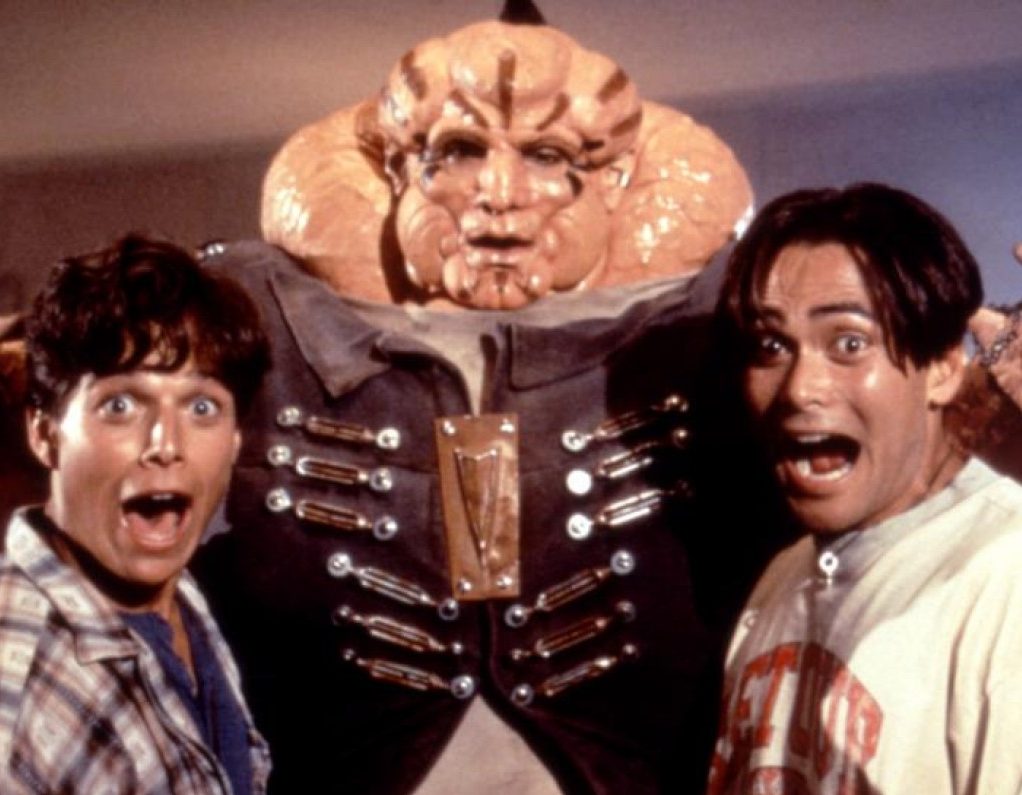
We realise that trash-talking video game movies feels like shooting fish in a barrel at this point, but still – just look at 1994’s Double Dragon. Arriving the year after Super Mario Bros and opening barely a month before Street Fighter, director James Yukich’s adaptation of the arcade favourite has the distinction of being only the second live-action video game movie ever made. However, Double Dragon is so dim-witted, juvenile and cartoonish, it makes Street Fighter look like Platoon. Admittedly the film makes a couple of good casting decisions, with expert martial artist and future John Wick 3 star Mark Dacascos as Jimmy Lee, and Terminator 2′s Robert Patrick on bad guy duties.
However, the clean-cut (and distinctly non-Asian) Scott Wolf is decidedly miscast as Billy Lee, and Alyssa Milano just seems to be wondering what she’s doing there. Still, as ridiculous fluorescent mid-90s visions of a post-apocalyptic future go, Double Dragon is definitely good for raising a few giggles.
3. Stigmata
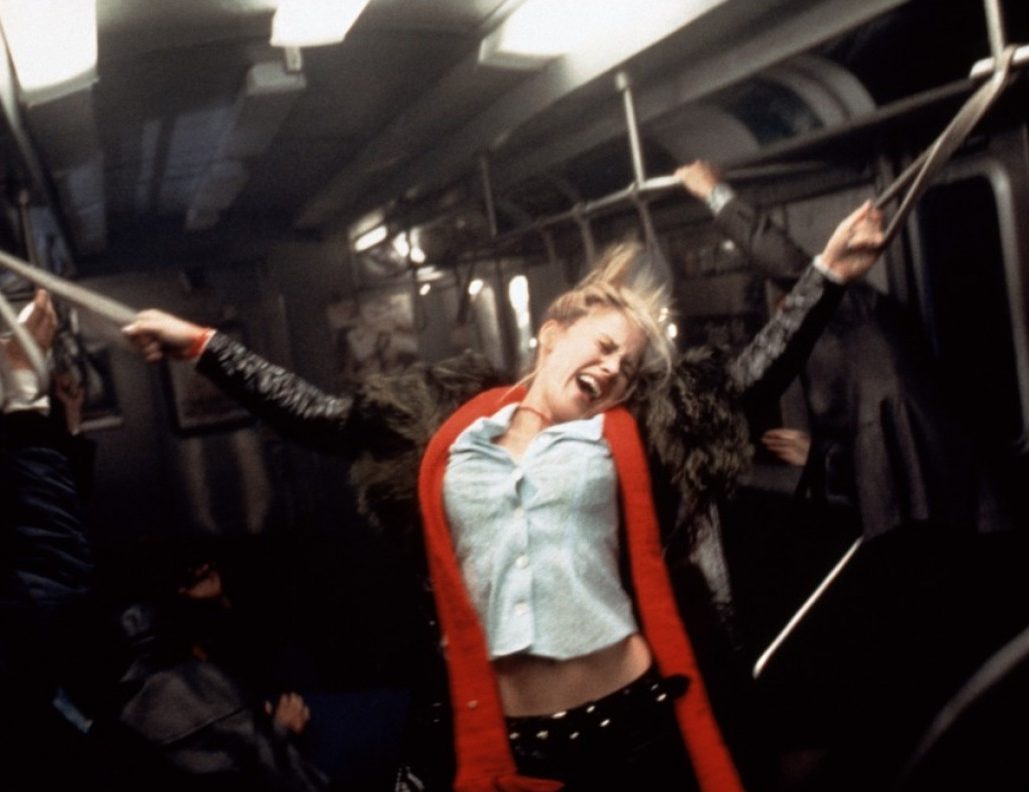
Released in autumn 1999, this lurid yet entirely straight-faced horror movie attempted to cash in on religious anxieties in the build-up to the new Millennium. No matter how seriously director Rupert Wainwright’s film seems to take itself, it’s almost impossible not to laugh at Stigmata’s outright absurdity. Patricia Arquette takes the lead as a textbook 90s party girl raver who unwittingly finds herself afflicted with the stigmata and experiencing religious visions.
Gabriel Byrne is the Vatican investigator put on the case, and who finds himself wrestling both with feelings for his new charge and suspicions that his superiors are concealing an almighty truth. With its bombastic tone and imagery, Stigmata is a breathtakingly pompous film. It’s also slightly heart-breaking to see future Oscar-winner Arquette squandering her talents on a role that mostly requires her to flail about hysterically, and spend extended periods of time lounging around scantily clad in her perpetually candlelit apartment. It’s perhaps surprising to note that Stigmata wound up a reasonable box office success (just over $89 million), despite almost universally negative reviews: Roger Ebert memorably declared it “possibly the funniest movie ever made about Catholicism.”
2. Alien Resurrection

When both the first and second films in a movie franchise are widely accepted as true masterpieces, that really puts the pressure on the filmmakers tasked with continuing the series. 1992’s Alien 3 demonstrated just how difficult it was to follow up Alien and Aliens – so hopes were high that things would get back on track with the fourth instalment. Alas, this wasn’t quite how things turned out. 1997’s Alien Resurrection was such a misfire it wound up killing the Alien series dead in its slimy tracks.
The movie gets around the death of Sigourney Weaver‘s Ripley in the previous film by bringing her back as a clone. However, as this new Ripley has a little Xenomorph DNA in her system, she’s a somewhat different character than we’re used to. Hand-in-hand with the shift in Ripley’s character, Alien Resurrection represents a massive shift in tone from what went before, with an ill-advised influx of would-be comedic one-liners and a puerile gross-out sensibility. Happily, director Jean-Pierre Jeunet would redeem himself with his acclaimed 2001 film Amélie, but the Alien series has never been the same since.
1. Highlander II: The Quickening
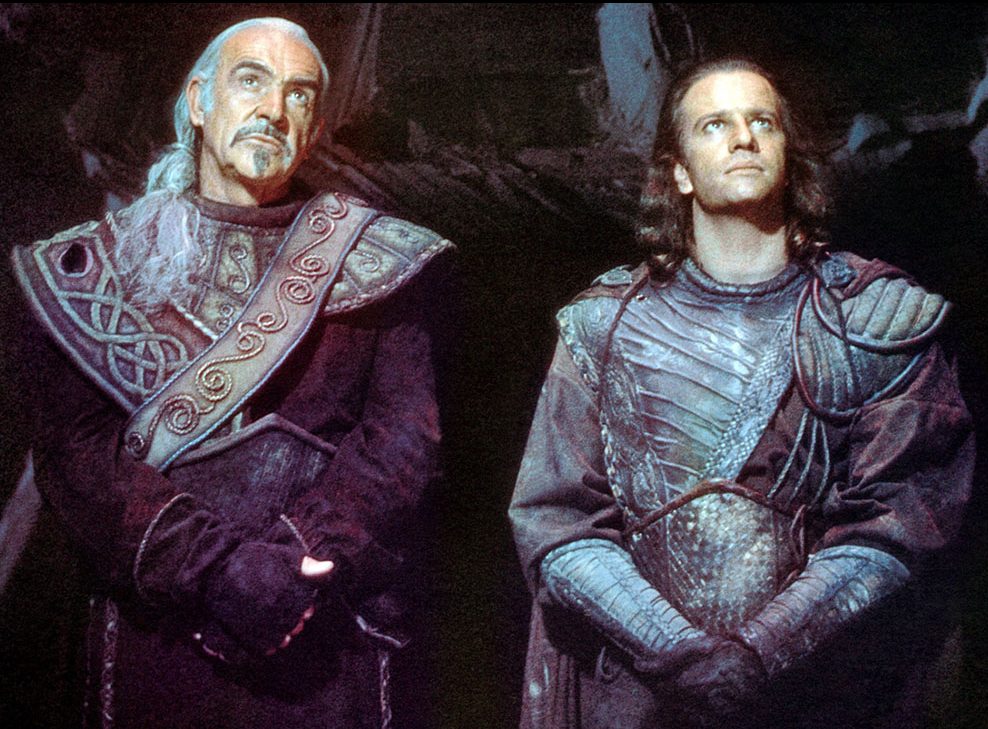
As the sheer number of sequels in the list might demonstrate (in case you haven’t been keeping count, this is the sixth), making a successful follow-up to a well-loved film can be a challenge. To filmmakers, we would make the following suggestion: if you can’t think of a smart way to do a sequel, then just don’t do it. Otherwise, you end up with movies like Highlander II: The Quickening. The makers of this world-class turkey had such difficulty coming up with a way to continue the story of 1986’s Highlander, they decided to blatantly ignore the events of that film and rewrite the central backstory.
Director Russel Mulcahy’s original film hinged on the existential angst of Christopher Lambert’s Connor Macleod, a man cursed with immortality for reasons he will never know. Highlander II: The Quickening, however, suddenly declares that Connor is immortal because he’s an alien, and acts as if this was something we knew all along. This is but one of the ridiculous, implausible and illogical plot devices that Highlander II: The Quickening brings to the table. It’s all so madcap, we barely even bat an eyelid when the very dead Ramirez (Sean Connery) inexplicably comes back. Small wonder that, while many Highlander sequels followed, they ignore the events of this movie altogether.

